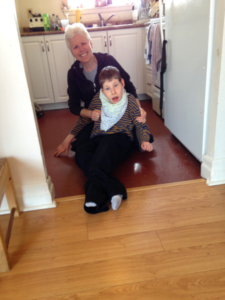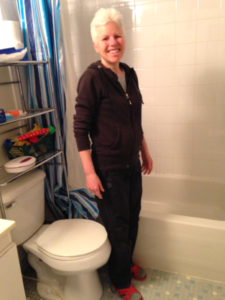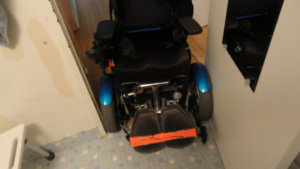People of all ages need barrier-free homes
Pamela Andrews struggles to get her 13-year-old son in or out of their
downtown Toronto apartment.
“The small lip on the threshold is very difficult to navigate in the power
wheelchair”, she says. “It doesn’t look big, but it makes it very difficult to
enter, and Aidan can’t get into the apartment by himself. I have to turn him
backwards and push the chair in while the power is on full throttle.”

Aidan in wheelchair at lip on threshold in entrance
The only entrance to the apartment is from an outdoor hallway. Pamela
explains, “Yes, snow has to be shovelled on our outdoor hallways. Aidan’s
wheelchair is pretty good in a few inches of snow, but not all wheelchairs
are.”
Aidan, who has cerebral palsy and does not speak, is working toward
learning to walk. At home, he hitches himself along the floor, and has
learned to get into bed.
Life would have been much easier if their apartment had been barrier-free
from the time Aidan was younger, and Pamela wishes they had a bigger
apartment where a larger walker would fit. She needs a larger space with a
roomy foyer, and a bigger bathroom with the possibility of installing a lift to
help her move Aidan into and out of the bathtub now that he is growing so
much heavier.

Small bathroom inadequate for Aidan’s needs
As they live in a rented co-op apartment, it is not possible to do much in the
way of renovations. She has made only minor modifications to the
apartment, such as easy-to-turn handles on the bathroom sink. The
bathroom entrance is too small for Aidan’s wheelchair.
Pamela would like to have a kitchen with a counter designed so Aidan’s
wheelchair can access it, as Aidan loves to help cook. Because there are
no doors on the kitchen, Pamela cannot shut it off. So she has to get up
early before the children awake to do any cooking & baking. She is afraid
Aidan might open the hot oven door and burn himself.
Pamela and Aidan in their kitchen IMG_0171.jp
Pamela expresses appreciation for the support of neighbours. The co-op
replaced the carpet with laminate flooring so Aidan could use his walker, redid
the foyer to protect it from denting by the wheelchair, provided extra
storage space for his equipment, and put in new doors with easy to open
lever handles. Because she does not own the apartment, she has been
unable to get March of Dimes renovation funding.

Aidan’s wheelchair barely squeezes through the doorway
Pamela says that she has community in the co-op, where she knows
everyone. It would be difficult to move now, even if a barrier-free unit were
to be found. “I did consider moving at one point to an accessible
apartment. We would have to get on a waiting list, wait a few years (until
someone died likely). But then Aidan would become an adult, and my
daughter and I would have to move again. Stability is important for me.
Plus I like this building. We have a community here in this neighbourhood
and in this building. So I stay. Its not great for Aidan, but its good for our
family.”
She worries: “ When Aidan is older, he will need his own universal design
place. – But where can he go?”